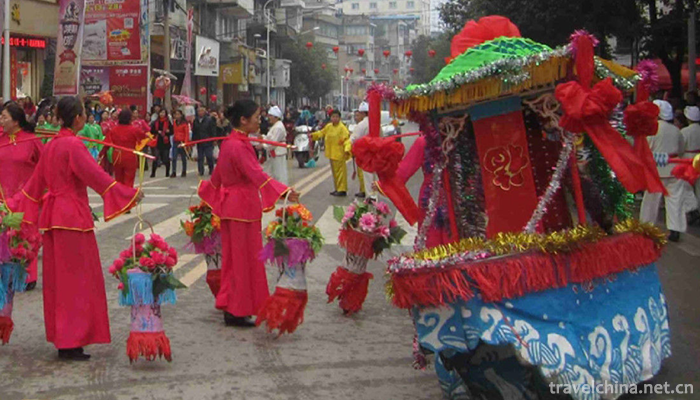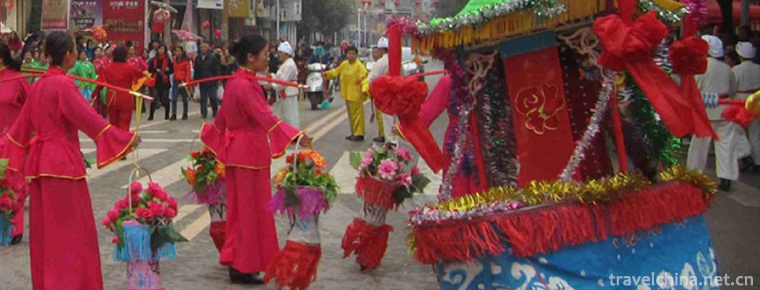Automative lighting
Automative lighting
Car lights are also known as "teasing Momei" and "running a dry boat". It is mainly performed around the Spring Festival.
On June 7, 2008, the car lights declared by Chongqing Quyi Troupe were listed in the second batch of national intangible cultural heritage list with the approval of the State Council. Heritage serial number: 781 V-88.
Form of performance
There were three performers, one for Momei, one for Xiaohua, and one for the rickshaw driver or Fuweng. There were also seven performers. In addition to the above three performers, four more "newspapers" (players) with lanterns were added. The lamp troupe is led by the old artists who are highly skilled in performing in the countryside. They connect some people who like to play with the lamp in series and temporarily form a "car lamp" troupe. During the Spring Festival, they play with the lamp everywhere, which will be dissolved immediately after the Spring Festival. The performance of "Car Lantern" starts with Xiao Huafa holding a flower folding fan running field, teasing out the younger sister (mostly dressed as a man) who sits in the "float", wears sunglasses and dances with handkerchiefs, and then improvises various kinds of funny words related to festivals, farming and folklore, mainly with humor and amusement. Momei handles the edge of the car in the boat and sways forward and backward with the lyrics, her face is charming and shy. The coachman or Fuweng paddles the cart in the shape of a boat according to the tune. After Xiaohualian led the singing, others helped to sing along. After each period of singing, the traditional routines such as "turning a treasure", "pulling ants" and "sifting lotus flowers" are used to transform the formation in the sound of gongs and drums. Its performance skills can be summarized as "a girl should be stable, a face should be amusing" eight characters, the aria has two parts: super-cavity and multi-cavity.
Libretto
Most of the lyrics belong to the upper and lower structure, with rhyming sentences. Most of them are seven-character sentences, often with linings and inlays. The singing tone is subtle and the tune repeats.
Accompaniment instrument
There are Erhu, Yueqin, March, Sihu, gongs, drums, four panels and so on.


-
2.Tiger Leaping Gorge
Tiger Leaping Gorge, known as "danger", is one of the deepest canyons in China
Time 2018-10-17 -
3.Xitang Ancient Town Tourist Scenic Spot
Xitang Town, belonging to Jiashan County, Jiaxing City, Zhejiang Province, is located at the junction of Jiangsu, Zhejiang and Shanghai. It has an ancient name of Xietang
Time 2018-12-07 -
4.Hometown of Zhu De
Zhude Hometown Scenic Spot: National AAAAA Tourist Scenic Spot, National Key Cultural Relics Protection Units, National Patriotic Education Demonstration Base, National Anti-corruption Education Base,
Time 2018-12-12 -
5.Four Seasons Hotel Shenzhen
Four Seasons Hotel is an international luxury hotel management group, headquartered in Toronto, Canada. It was founded by Mr. Isado Sharp in 1961. Now it has more than 90 hotels and resorts in nearly
Time 2018-12-16 -
6.Fengyang flower drum
Fengyang flower drum is also known as "flower drum", "beating flower drum", "flower drum gong", "double drum" and so on. Fengyang flower drum originated in Linh
Time 2019-04-29 -
7.Henan Pendant
Henan pendant originated in Henan Province. It is a traditional form of folk art which is formed by the combination of Taoism, Yinggeliu and Sanxianshu, which are popular in Henan and Northern Anhui.
Time 2019-05-03 -
8.Nau Song of Jingpo Ethnic Group
The Jingpo Munao Longitudinal Song is the most solemn traditional national festival of the Jingpo nationality and one of the national intangible cultural heritages.
Time 2019-05-08 -
9.temple fair
Temple fair, also known as "temple market" or "festival venue". It is a Chinese folk religion and the custom of the age. It is usually held on the Lunar New Year, the Lantern Festi
Time 2019-06-05 -
10.Water Encouragement
Water drum dance is a kind of popular dance spread between the De'ang and Miao nationalities. It combines water, drum and dance to worship ancestors, pray for good weather and peace in villages. Howev
Time 2019-06-15 -
11.Hunan Opera
Hunan Opera, is one of the traditional operas in Hunan Province. It is popular in Changsha and Xiangtan, mainly in the twelve genera of Changsha Mansion, namely Changsha, Shanhua, Xiangyin, Liling, Xi
Time 2019-07-03 -
12.medical and health work
By the end of 2019, there are 2139 medical and health institutions with 19943 beds. At the end of the year, there were 14351 technical personnel in hospitals and health centers, including 4839 licensed doctors and 6767 registered nurses. The numbe
Time 2020-12-18